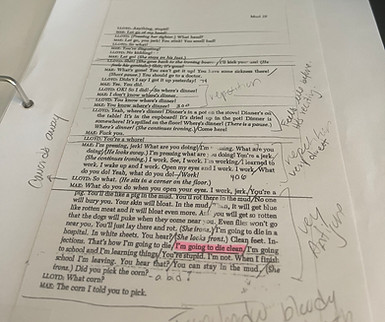My Process as a Director
Research and Discovery
I’m an analytical director who loves to get lost in the world of a play. My process begins with deep research—learning as much as I can about the playwright, the play’s original production, and the cultural moment in which it was first performed. Understanding what audiences felt when they first encountered the work helps guide how I bring it to life for today’s audiences. I explore how the world of the play translates into its visual and emotional landscape—set, costumes, tone, and aesthetic—often through extensive visual research. I draw on methodologies like David Ball’s Backwards and Forwards to uncover the mechanics of storytelling and seek out moments of theatricality that make the piece larger than life.
Samples from my director’s notebook during my analysis of María Irene Fornés


Tablework and Rehearsal Norms
When rehearsals begin, I distill my research into a concise “crib sheet” that serves as an entry point for company discussions about the play’s themes and the playwright’s intentions. Tablework is an essential part of my process—it ensures we’re all telling the same story and living in the same world. Drawing on my background in corporate facilitation, I lead structured yet open sessions that combine discussion and tailored exercises around theme, character, and world-building. Rehearsal norms are grounded in what I call our “company character,” a shared understanding of how we collaborate and communicate with respect, curiosity, and generosity.
Company Charter from Last of the Red Hot Robots & Mud


Crib Sheet Examples:
Flip chart Examples:
Collaboration in Rehearsal
In the rehearsal room, I view my role as both guide and collaborator. I often integrate Viewpoints exercises to help the ensemble tap into the play’s physical vocabulary and strengthen their collective rhythm. During blocking and scene work, I encourage actors to follow their impulses, explore possibilities, and engage in active dialogue about what’s happening moment to moment. I invite everyone in the room to make an “offering”—to share ideas, observations, or experiments—because I believe the best theater emerges when every artist feels empowered to contribute to the storytelling.








